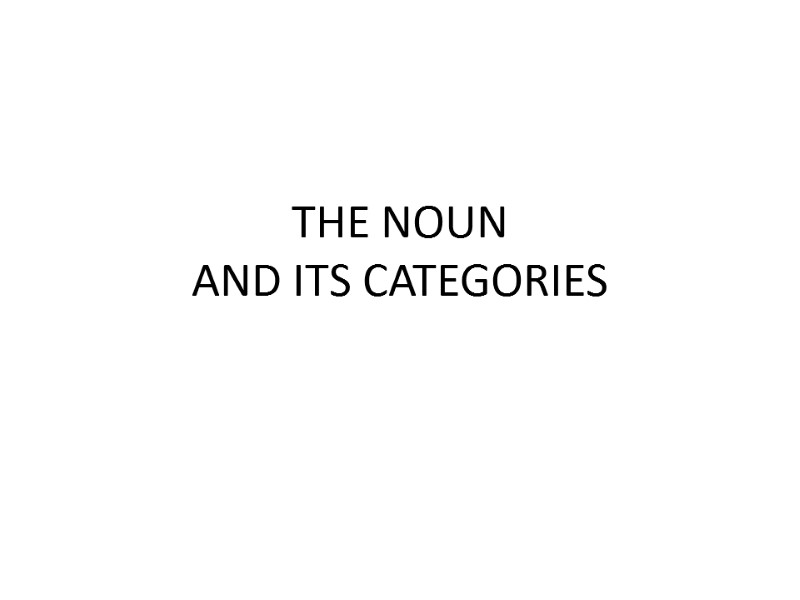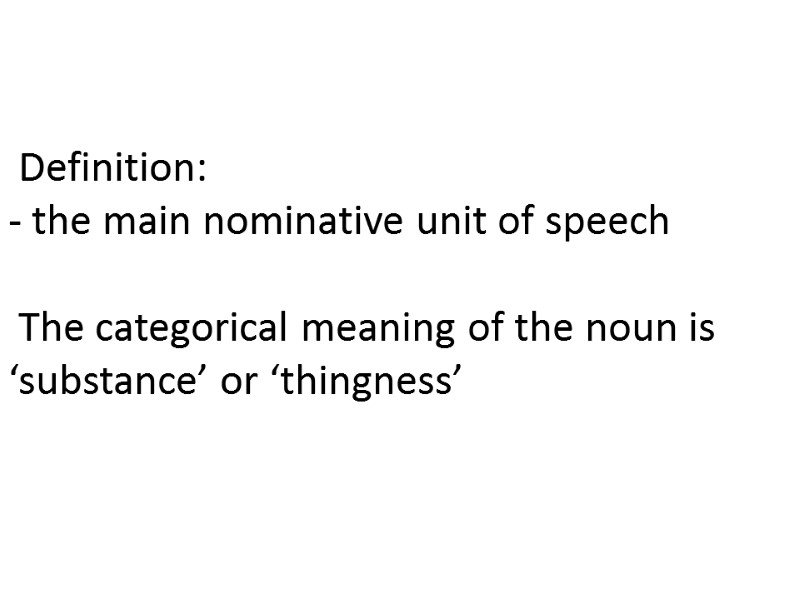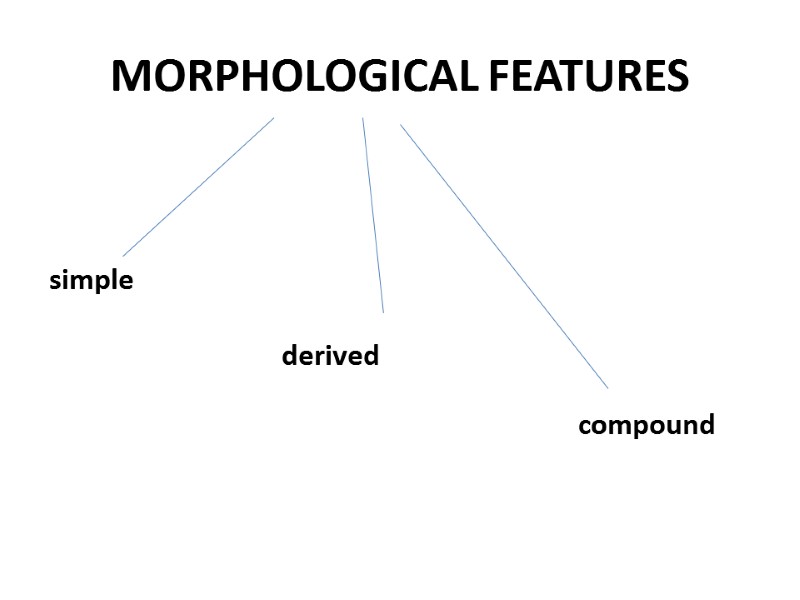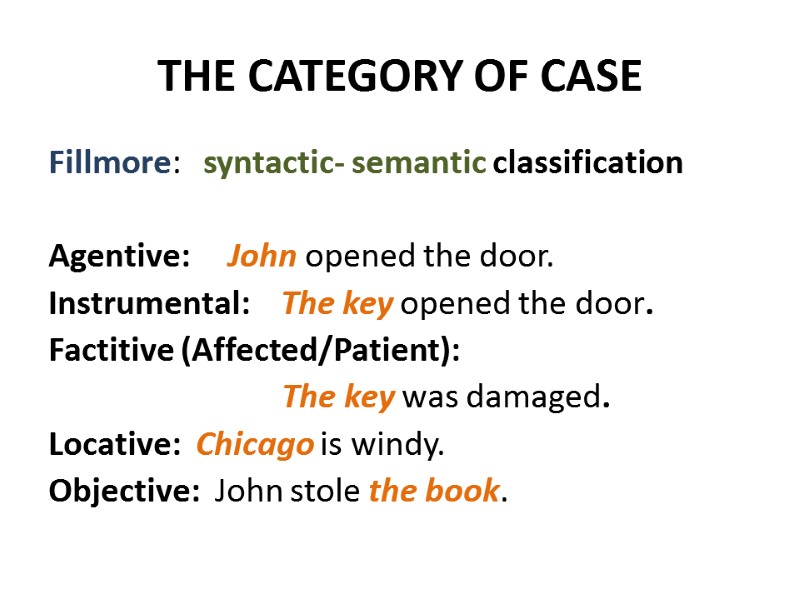THE NOUN AND ITS CATEGORIES Definition: — the




















11566-the_noun.ppt
- Количество слайдов: 19
 THE NOUN AND ITS CATEGORIES
THE NOUN AND ITS CATEGORIES
 Definition: - the main nominative unit of speech The categorical meaning of the noun is ‘substance’ or ‘thingness’
Definition: - the main nominative unit of speech The categorical meaning of the noun is ‘substance’ or ‘thingness’
 NOUN semantic morphological syntactical
NOUN semantic morphological syntactical
 SEMANTIC CHARACTERISTICS
SEMANTIC CHARACTERISTICS
 Consider: Proper or Common? There’s an Alice on the phone. Is that the Alice you told me about? There’s a Broadway in almost every city. The Broadway I’m referring to is in New York City.
Consider: Proper or Common? There’s an Alice on the phone. Is that the Alice you told me about? There’s a Broadway in almost every city. The Broadway I’m referring to is in New York City.
 Countable or Uncountable? a) She likes lemon in her tea. I taste onion in the salad. b) Would you like tea? Here’s a lemon. There’s a large onion in the salad. Would you like a green tea or a black tea? c) He has a courage equaled by few of his contemporaries. A knowledge of English is needed for this job.
Countable or Uncountable? a) She likes lemon in her tea. I taste onion in the salad. b) Would you like tea? Here’s a lemon. There’s a large onion in the salad. Would you like a green tea or a black tea? c) He has a courage equaled by few of his contemporaries. A knowledge of English is needed for this job.
 MORPHOLOGICAL FEATURES simple derived compound
MORPHOLOGICAL FEATURES simple derived compound
 MORPHOLOGICAL CATEGORIES NUMBER CASE
MORPHOLOGICAL CATEGORIES NUMBER CASE
 THE CATEGORY OF NUMBER Oneness vs. non-oneness Unmarked vs. Marked Regular vs. Irregular Plurals Variable vs Invariable nouns Singularia tantum vs. Pluralia tantum
THE CATEGORY OF NUMBER Oneness vs. non-oneness Unmarked vs. Marked Regular vs. Irregular Plurals Variable vs Invariable nouns Singularia tantum vs. Pluralia tantum
 INVARIABLES SINGULAR vs. PLURAL Uncountable nouns Abstract Proper nouns Nouns ending in –ics Names of certain diseases Summation plurals Unmarked plural nouns Pluralia tantum in –s Some proper nouns
INVARIABLES SINGULAR vs. PLURAL Uncountable nouns Abstract Proper nouns Nouns ending in –ics Names of certain diseases Summation plurals Unmarked plural nouns Pluralia tantum in –s Some proper nouns
 THE CATEGORY OF CASE A marker of syntactic relation: H. Sweet: inflected vs. non-inflected (genitive vs. common) non-inflected: nominative, vocative, accusative, dative O. Jespersen: genitive vs. common G. O. Curme: nominative, accusative, dative, genitive
THE CATEGORY OF CASE A marker of syntactic relation: H. Sweet: inflected vs. non-inflected (genitive vs. common) non-inflected: nominative, vocative, accusative, dative O. Jespersen: genitive vs. common G. O. Curme: nominative, accusative, dative, genitive
 THE CATEGORY OF CASE Fillmore: syntactic- semantic classification Agentive: John opened the door. Instrumental: The key opened the door. Factitive (Affected/Patient): The key was damaged. Locative: Chicago is windy. Objective: John stole the book.
THE CATEGORY OF CASE Fillmore: syntactic- semantic classification Agentive: John opened the door. Instrumental: The key opened the door. Factitive (Affected/Patient): The key was damaged. Locative: Chicago is windy. Objective: John stole the book.
 GENITIVE CASE (semantic relations between the constituents) POSSESSIVE GENITIVE (a has b): Mary’s father SUBJECTIVE GENITIVE (a does b):the doctor’s arrival OBJECTIVE GENITIVE: the man’s release: (the man was released) GENITIVE OF ORIGIN : the girl’s story (the girl told the story) EQUATION GENITIVE (GENITIVE OF MEASURE) : ten days’ absence DESCRIPTIVE GENITIVE : women’s college
GENITIVE CASE (semantic relations between the constituents) POSSESSIVE GENITIVE (a has b): Mary’s father SUBJECTIVE GENITIVE (a does b):the doctor’s arrival OBJECTIVE GENITIVE: the man’s release: (the man was released) GENITIVE OF ORIGIN : the girl’s story (the girl told the story) EQUATION GENITIVE (GENITIVE OF MEASURE) : ten days’ absence DESCRIPTIVE GENITIVE : women’s college
 GENITIVE CASE Group genitive: Mum and Dad’s room Absolute genitive: Our house is better than Mary’s. the cousin of my husband’s; St Paul’s At Timothy’s
GENITIVE CASE Group genitive: Mum and Dad’s room Absolute genitive: Our house is better than Mary’s. the cousin of my husband’s; St Paul’s At Timothy’s
 Specific features of genitive the inflection ‘s is but loosely connected with the noun: the Queen of England’s daughter; the man I met yesterday’s son genitive constructions are parallel to corresponding prepositional construction: Shakespeare’s works // works of Shakespeare the use of genitive is mainly limited to nouns denoting living beings;
Specific features of genitive the inflection ‘s is but loosely connected with the noun: the Queen of England’s daughter; the man I met yesterday’s son genitive constructions are parallel to corresponding prepositional construction: Shakespeare’s works // works of Shakespeare the use of genitive is mainly limited to nouns denoting living beings;
 CASE THEORIES: 1)the theory of positional cases, which identifies the syntactic position with the case; 2)the theory of prepositional cases, which treats prepositional constructions as analylical cases; 3)the theory of limited cases, which recognises a two-case system; 4)the theory of “null” case, which argues that English has completely lost the category of case.
CASE THEORIES: 1)the theory of positional cases, which identifies the syntactic position with the case; 2)the theory of prepositional cases, which treats prepositional constructions as analylical cases; 3)the theory of limited cases, which recognises a two-case system; 4)the theory of “null” case, which argues that English has completely lost the category of case.
 Gender Lexic-semantic means: man-woman Syntactic means (be the addition of a word): grandfather-grandmother she cat -he cat by the use of suffixes: host-hostess
Gender Lexic-semantic means: man-woman Syntactic means (be the addition of a word): grandfather-grandmother she cat -he cat by the use of suffixes: host-hostess
 Syntactic Functions: Subject: The stone is cold. Direct Object: I took the stone. Indirect Object: He broke the window with a stone. Attribute: a stone wall Predicative: It is a stone.
Syntactic Functions: Subject: The stone is cold. Direct Object: I took the stone. Indirect Object: He broke the window with a stone. Attribute: a stone wall Predicative: It is a stone.
 В 1: Define the gender characteristics of the following nouns - teacher, smoke, landlord, hostess. A. feminine B. neuter gender C. common gender -D. masculine – 2.Identify the meaning of the genitive: children’s language; an hour’s drive 3. Identify the syntactic function: A dog is a man’s best friend. В 2: Define the gender characteristics of the following nouns - conductor, house, Tom-cat, heroine. A. feminine B. neuter gender C. common gender -D. masculine – 2.Identify the meaning of the genitive: at my uncle’s; the car’s wheel 3. Identify the syntactic function: I found him an excellent listener. В 3: Define the gender characteristics of the following nouns - doctor, bull, usherette, ship. A. feminine B. neuter gender C. common gender -D. masculine – 2.Identify the meaning of the genitive: the family’s support; the children’s room 3. Identify the syntactic function: Twelve dollars are enough for the man.
В 1: Define the gender characteristics of the following nouns - teacher, smoke, landlord, hostess. A. feminine B. neuter gender C. common gender -D. masculine – 2.Identify the meaning of the genitive: children’s language; an hour’s drive 3. Identify the syntactic function: A dog is a man’s best friend. В 2: Define the gender characteristics of the following nouns - conductor, house, Tom-cat, heroine. A. feminine B. neuter gender C. common gender -D. masculine – 2.Identify the meaning of the genitive: at my uncle’s; the car’s wheel 3. Identify the syntactic function: I found him an excellent listener. В 3: Define the gender characteristics of the following nouns - doctor, bull, usherette, ship. A. feminine B. neuter gender C. common gender -D. masculine – 2.Identify the meaning of the genitive: the family’s support; the children’s room 3. Identify the syntactic function: Twelve dollars are enough for the man.

